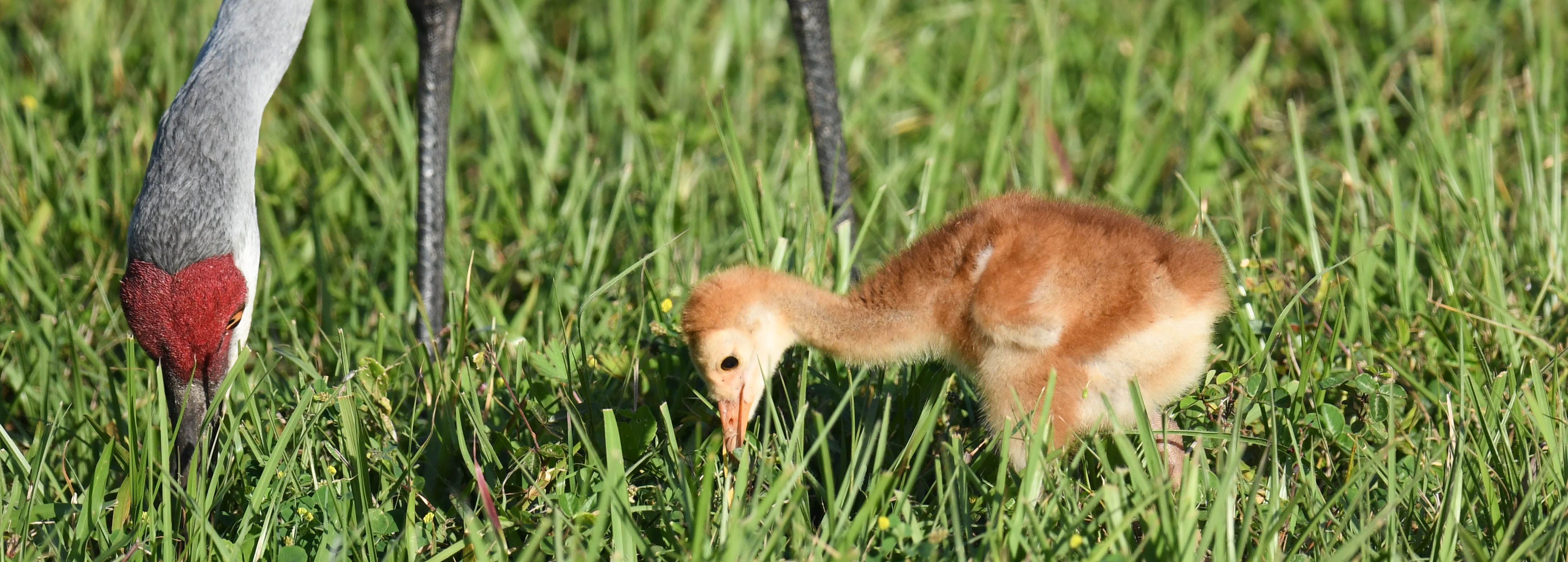
By Beverly Gyllenhaal
Audubon’s annual Nebraska Crane Festival starts today, where 80 percent of the world’s cranes are converging on one 80-mile stretch of land. More than half a million Sandhill Cranes will touch down in central Nebraska this spring to fatten up before migrating north to their breeding grounds.

Meanwhile, in central Florida, some 5,000 very unusual Sandhill Cranes aren’t going anywhere.
Florida is home to a sub-species of Sandhill Crane that never migrates. While their cousins in other parts of the U.S. are so skittish they’d never stay still for a photo, Florida’s cranes are urban birds unafraid of people.
There may be tens of thousands of Sandhill Cranes near Kearney, Nebraska, for the festival this week, but to see one up close you’d have to hide behind a bird blind. If you’re in Florida, like Anders and I are for a winter birding trip, the crazy cranes are grazing on golf courses, standing in people’s front yards and walking alongside major roadways without showing a care in the world.

Because Florida’s suitable crane habitat has been shrinking for years, these native birds have grown accustomed to sharing space with humans. (Sandhill Cranes can live up to 35 years and mate for life.) State law forbids feeding cranes, but it’s not unusual for them to walk right up to your car hoping for a handout.
You’re not likely to forget a close encounter with a Sandhill Crane. Statuesque at 4 feet tall, with leathery crimson skin on their faces and gray-and-brown feathers that fan out at the hips like a skirt, these birds are astonishing. Cranes are among the world’s oldest living birds and one of the planet’s most successful life forms, having outlasted millions of species. The Sandhill Cranes of North America have not changed appreciably in ten million years.
Last week we took some friends visiting from the Midwest to a freshwater marsh near Titusville, Florida. A pair of cranes strolled within five feet of us, followed by two newly hatched chicks, called colts.

Everywhere else, migrating Sandhill Cranes tend to hide in remote areas to build their summer nests – some going as far north as Siberia. But in Florida, a native crane has to take whatever shallow wetlands she can get for an elongated breeding season that can stretch from December to August.

(By the way, it’s against state law to approach a nesting crane, as the native Florida population is a threatened species. Also, for the record, some 25,000 “regular” Sandhill Cranes winter in Florida, but by early March, they’ve all left for their breeding grounds in the northern U.S. and Canada. The two types of cranes are genetically distinct, behave differently and don’t interbreed.)
Click here for our photo gallery on the Cranes. And to see what the Sandhill Crane migration looks like week by week as the birds move across the country, click on the video below for a new migration animation from the Cornell Lab of Ornithology. Finally, here’s a link to the Nebraska Festival website.
Fortunately for birders hoping to see them, Sandhill Cranes aren’t limited to Florida and Nebraska. There are six geographically distinct migration routes cranes take twice a year – the Eastern and Pacific Flyways, Mid-Continent, Rocky Mountain, Lower Colorado River and Central Valley.





Leave a Reply